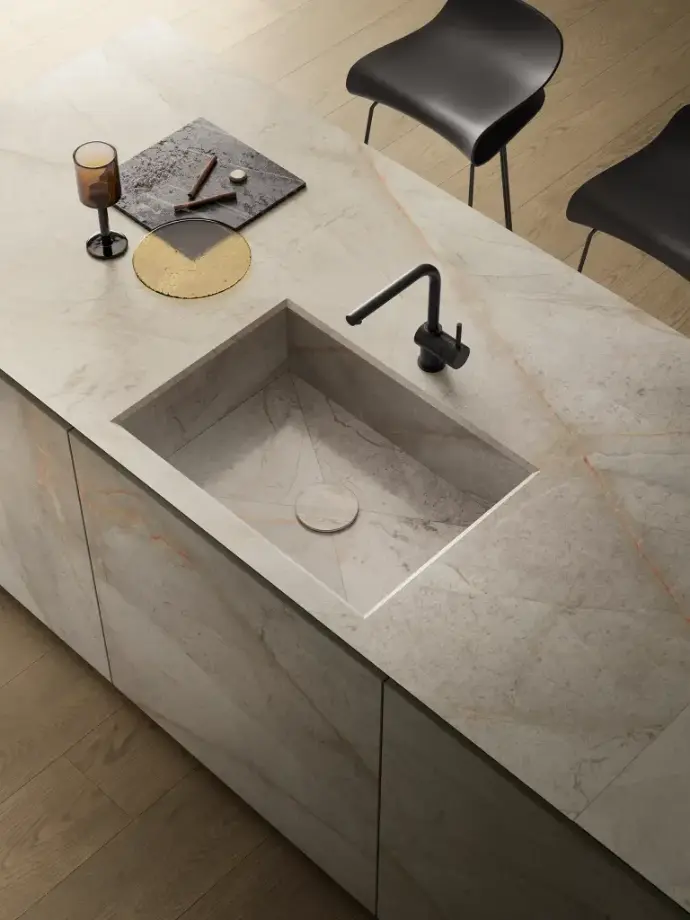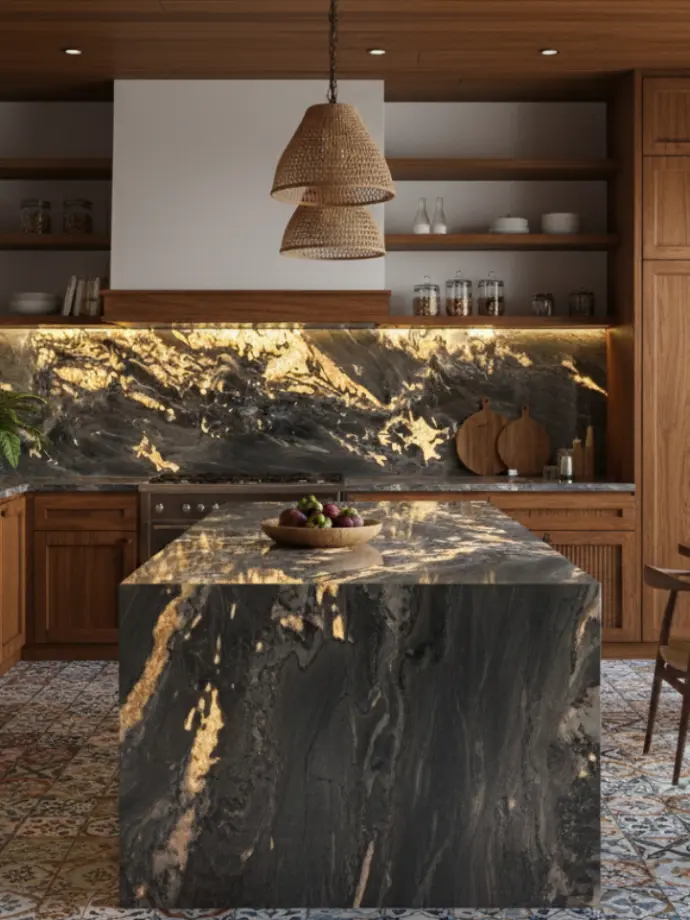Choosing a kitchen countertop in Malaysia often comes down to two heavyweights: quartz and sintered stone (aka porcelain slab). This guide combines our most useful advice into one place—so you can decide confidently based on sunlight exposure, cooking style, durability needs, and design preferences.
TL;DR — Quick Picks
- If your kitchen gets direct sunlight or you’re building an outdoor/wet kitchen: choose sintered stone (resin‑free and UV‑proof).
- If your kitchen is mostly indoor with no direct UV and you cook often: choose quartz (excellent day‑to‑day durability, impact tolerance, and consistent looks).
What They’re Made Of (and Why It Matters)
- Quartz is ~90–95% crushed natural quartz bound with polymer resins and pigments—delivering a hard, non‑porous, consistent surface ideal for busy homes. The resin adds toughness and slight flex, which helps resist chipping and cracking in normal use.
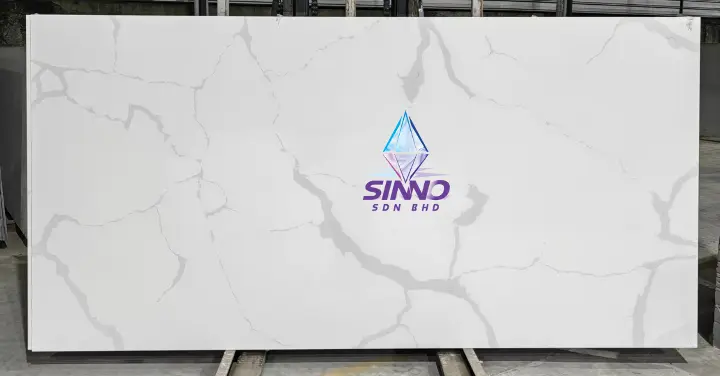
- Sintered Stone is made by compressing and firing natural minerals at very high temperature (around 1200 °C), creating an ultra‑dense, resin‑free slab that excels in heat, scratch and UV resistance.
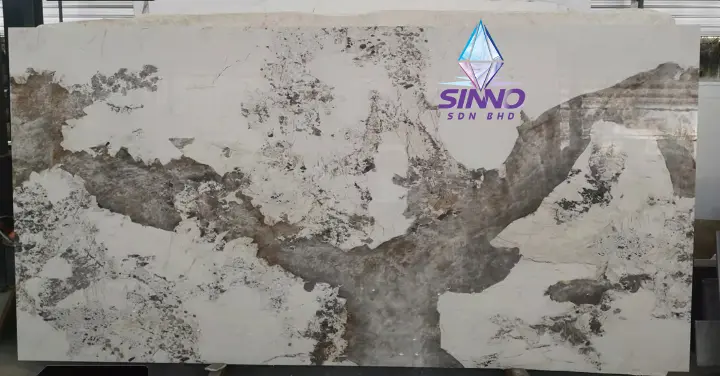
The Big Decider: Sunlight & UV
If your countertop sees direct sun (east/west windows, skylights, or outdoor use), avoid quartz because resin can yellow or fade under UV. Sintered stone’s zero‑resin makeup makes it UV‑stable, so colour holds even with prolonged exposure.
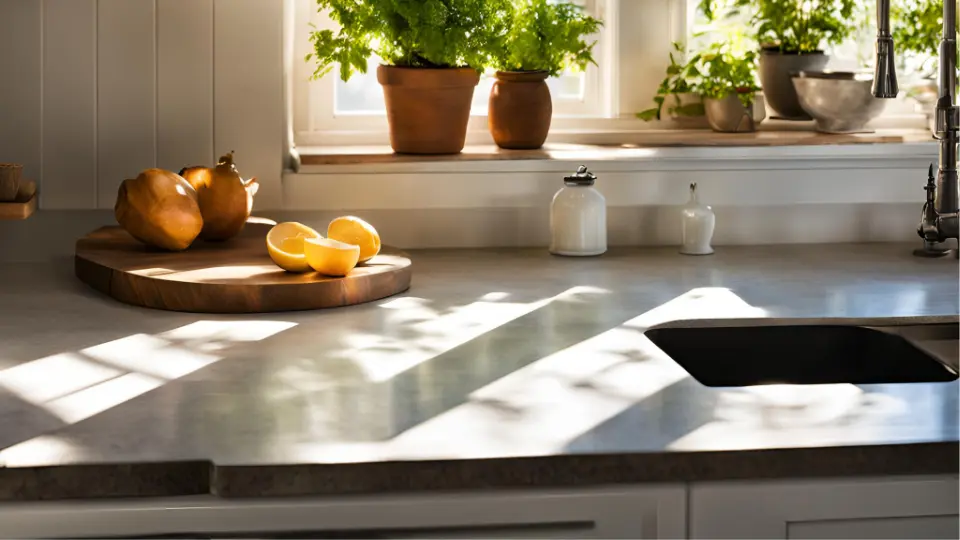
Performance, Side‑by‑Side
| Category | Quartz | Sintered Stone |
|---|---|---|
| Heat Resistance | Up to ~150 °C; use a trivet for hot wok/pan shocks | Up to ~300 °C; far more tolerant of direct heat (still use trivets for safety) |
| UV Resistance | Not UV‑stable; indoor use only | UV‑stable; suitable for bright, sunlit, or outdoor settings |
| Stain Resistance | Non‑porous, high | Non‑porous, high |
| Scratch Resistance | Very Good | Excellent (ultra‑dense) |
| Impact Resistance | Better (resin adds toughness/flex) | More brittle; heavy point impact at weak spots can chip or crack |
| Design/Finish | Widest consistent colours; true polished finish | Stunning stone/metal/wood looks; many have surface‑printed veins |
| Edges | Homogeneous; no vein break; creative profiles feasible | Recommend 3 mm chamfer to reduce chip risk (can reveal 2‑tone edge) |
Real‑World Pros & Cons (What You’ll Notice Over Time)
Quartz — Why Home Cooks Love It
- Tough daily driver: resists dents and chips from normal bumps; if hit hard, more likely to mark/dent than crack.
- Easy care: non‑porous and highly stain resistant—great for kunyit, curry, kopi spills.
- Polished finish stays polished: there’s no glaze layer to wear off.
- Edge creativity: ogee, pencil, mitre—profiles are easier thanks to material flexibility and full‑body homogeneity.
Watchouts: not UV‑safe; sudden high heat can damage resin—always use a trivet.
Sintered Stone — The High‑Heat, UV‑Proof Powerhouse
- Heat champion: shrugs off hot pans better than quartz (still practice safe placement).
- Scratch star & outdoor‑ready: ultra‑dense and UV‑stable for sun‑drenched or outdoor kitchens.
- Designer looks: dramatic marble/stone effects; multiple finish choices (gloss, matt, leather, etc.).
Watchouts: many Malaysian‑market slabs have printed surface veins (≈1 mm)—edges and post‑polishing can show vein breaks; glaze‑gloss finishes can micro‑scratch with friction over time; and corners/edges can chip if struck—use ~3 mm chamfer to reduce risk (accept the slight 2‑tone look).
Even top‑tier sintered stones can show impact limitations in independent tests; normal home use is fine but avoid dropping heavy items on edges and weak points.
How to Choose in 3 Questions
- Does your top get direct sunlight?
- Yes → Sintered stone.
- No → Go to #2.
- Do you cook heavily and want worry‑free heat?
- Yes → Sintered stone has the heat edge.
- No or moderate → Either works—go to #3.
- Do you prioritise impact tolerance, edge profiles, and long‑term polished look?
- Yes → Quartz (tougher against knocks, homogeneous edges, no glaze wear).
- No → Pick based on design/finish you love.
Fabrication & Finish Tips (Important!)
- Edge treatment for sintered stone: specify ~3 mm chamfer on exposed edges to help reduce chip‑off; be ready for a two‑tone visual where the body/glue shows.
- Gloss vs polished: many sintered stones use a glaze gloss (not a true polish); friction over time can create fine lines—consider matt/smooth‑matt for heavy cooking zones. Quartz’s polished surface stays stable.
- Vein continuity: because many sintered options are not full‑body, expect vein breaks at cut/edge areas; quartz patterns are more consistent through edges.
Specs Snapshot
- Mohs hardness: Quartz ~5–7; Sintered ~6–8. Both resist everyday abrasion.
- Heat: Quartz up to ~150 °C; Sintered up to ~300 °C.
- Porosity & stains: both non‑porous and easy to clean.
- Acids: high resistance for both.
- UV: quartz can fade/yellow; sintered is UV‑resistant.
Recommended Use Cases
- Choose Quartz if you want: a durable, low‑maintenance indoor surface that tolerates daily knocks, offers wide and consistent colours, and supports creative edge profiles.
- Choose Sintered Stone if you need: UV stability, top‑tier heat/scratch performance, or you’re designing an outdoor/wet or sun‑bathed kitchen with dramatic natural‑stone looks.
Care Basics (Whichever You Pick)
- Use trivets for very hot cookware (especially on quartz).
- Wipe spills early (curry, turmeric, coffee) even though both are non‑porous, to keep surfaces pristine.
- For sintered stone, protect edges/corners and consider that glossy glaze may show micro‑scratches over time in heavy‑use zones.
Bottom Line
- Indoor family kitchen, heavy daily use, no direct sun? → Quartz.
- Bright, sun‑exposed or outdoor kitchen, or want maximum heat/scratch resistance? → Sintered stone.
